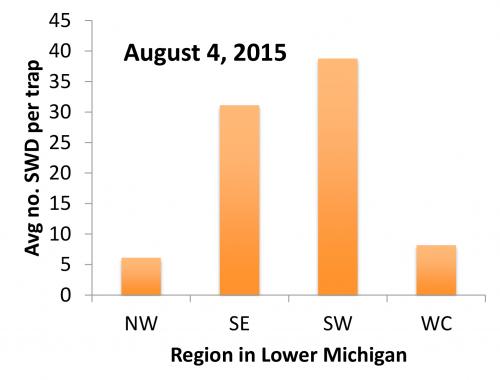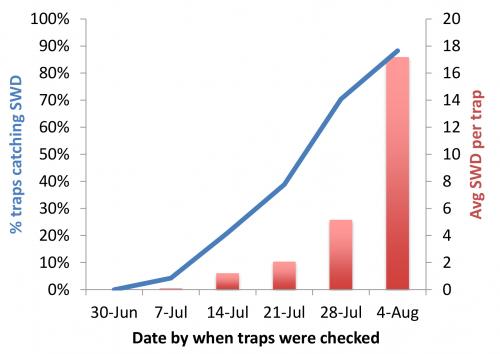Michigan spotted wing Drosophila report for August 4, 2015
Summer increase of spotted wing Drosophila continues. Ripening susceptible crops need to be protected.
This is the eighth weekly report of the Michigan State University Extension spotted wing Drosophila (SWD) monitoring network. Traps in the network are baited with Trece lures and placed near susceptible crops and wild hosts in each of the major fruit growing regions across the state. Commercial plantings include strawberries, blueberries, raspberries, grapes, tart and sweet cherries, peaches and plums. Wild hosts in the trapping network include autumn olives, black cherries, pin cherries, choke cherries, blackberries, honeysuckle, mulberries and wild grapes.
The summer increase of SWD continues with a majority (88 percent) of all of sites in the network reporting SWD in traps this week. The overall pattern of fly captures is similar to last week with the highest per trap average continuing to come from traps in the southwest region. There were 838 females and 1,070 males for a total of 1,908 SWD captured in 98 traps out of the more than 110 traps being monitored as part of the network this week. This is almost three times as many SWD caught in traps last week.
We are also hearing a few reports of some growers struggling to keep full protection against this pest due to increasing pest pressure and continued rains that have come through the region recently. It is essential to maintain fruit protection on ripe or ripening fruit that are susceptible to prevent this increasing pest pressure from resulting in larval infestation of that fruit. Consult MSU’s SWD website where there are crop recommendations for berry crops.
Thin-skinned fruit, particularly cherries, blueberries and raspberries, are at high risk of being infested and need to be protected. Last week, we suggested using the salt test as a back-up measure to test whether protective measures are working or if your management program needs to be adjusted. For instructions on how to conduct a salt test, please refer to the July 28 SWD report.
For instructions on how to construct your own traps and use them for monitoring for SWD, please visit the MSU Spotted Wing Drosophila website. For specific recommendations about managing SWD in berry crops, please see “Increase of spotted wing Drosophila in berry crops.”

Average number of spotted wing Drosophila flies caught in traps in four Michigan fruit production regions. This week: NW = 60 traps in Antrim, Benzie, Grand Traverse, Leelanau and Manistee counties; SE = 9 traps across Genesee, Ingham, Lapeer, Lenawee, Livingston, Macomb, Monroe and Oakland; SW = 30 traps across Allegan, Berrien, Kalamazoo, Ottawa and Van Buren; and WC = 12 traps in Ionia, Kent and Oceana.

Average number of spotted wing Drosophila (SWD) captured per trap (red bars) and the percentage of traps that captured any SWD (blue line) across the entire trapping network by week starting June 30, 2015.



 Print
Print Email
Email


